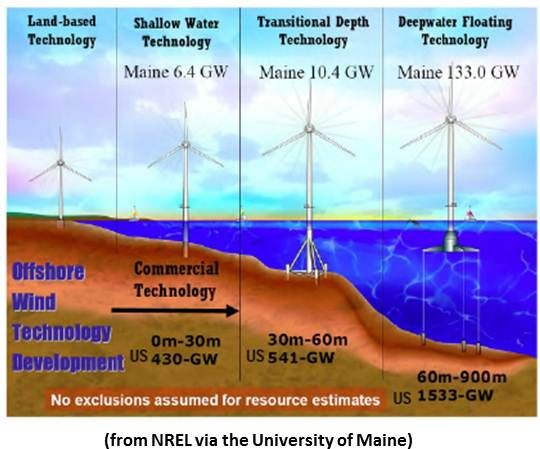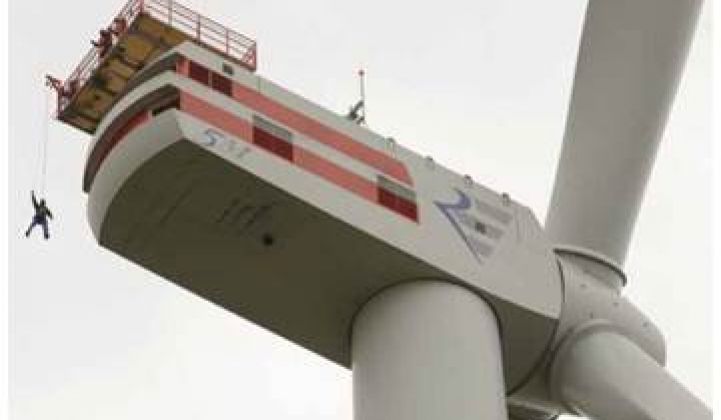At the heart of the Obama administration’s push to grow wind power, said Jose Zayas, Wind and Water Power Program Manager at the U.S. Department of Energy, are two targets: reducing the overall cost of wind-generated electricity and advancing offshore wind. For each, Zayas said, the Department has a “multi-pronged approach” and a portfolio of programs of both depth and breadth.
Land-based turbines, Zayas said, will not get much bigger than the 2.5-megawatt to 3-megawatt machines currently deployed because of transportation logistics, such as bridge heights and the curvatures of roads, and construction logistics, such as the lifting capacity of cranes.
The DOE’s focus for land-based wind is therefore on bringing down costs through advanced technologies and higher efficiencies. An example of DOE portfolio depth, Zayas said, is its two new programs funding advances in Permanent Magnet Generator (PMG) technology and Constant Velocity Transmission (CVT) technology.
For offshore, however, the future might bring “an infrastructure and a supply base institutionalized around manufacturing near shore,” Zayas said, adding, “Turbines can be barged out, so a lot of the transportation constraints are removed.”
As a result, Zayas explained, “the economics change drastically [ ... and] you want to put in the biggest machine possible. That’s when people start talking about machines of seven and even ten-plus megawatts.”
In Europe, “five-megawatt machines are being tested,” he said, adding, “OEMs have machines of double-digit megawatts either on the drawing boards or in pre-prototype testing.”

“The three-word pitch for offshore wind in the United States,” pioneering offshore developer Peter Mandelstam recently told GTM, is “proximity to load.” Some 55 million people live along the Eastern Seaboard and rich winds adjacent to some of the nation’s highest-priced utility districts, Mandelstam said, make offshore wind-generated electricity “a terrific deal for ratepayers.”
Neither DOE loan guarantees nor the federal Production Tax Credit (PTC), wind’s historically crucial but now threatened incentive, have been adequate to support offshore wind. As a result, Mandelstam said, “there are no banks in the world willing to finance offshore wind in the United States.” By contrast, at least nine European ocean wind projects have found bank support for the billion dollar financing ocean wind projects require.
U.S. offshore developers, Mandelstam said, need two things, (1) sound planning and (2) the stable, long term policies and incentives that have driven the installation of over 1,000 megawatts of capacity in Europe, where 8,000 megawatts more are planned.
Zayas said DOE is working to provide planning support and research funding for wind because it offers an even better incentive to domestic manufacturing and jobs than other renewables.
The “transportation component” of the cost of the huge turbines is significant enough to justify the buildup of a “localized manufacturing and installation base” for wind (and especially for offshore wind). “We see that as a big opportunity,” Zayas said. “It’s an area where investment is much needed” and DOE is making just such “strategic investments.”
The emerging “opportunity in offshore,” Zayas said, can revitalize underused port facilities and drive economic renewal. It will grow manufacturing and installation infrastructure and jobs, he said, in “everything from vessels to the technology itself.”

For land-based wind, DOE is pushing for ways to increase the U.S.-made turbine component content “at our national laboratories, at academic institutions and in partnership with the industry.”
To master offshore wind’s challenging combination of hydrodynamics and aerodynamics, Zayas said, entirely new technology is needed, because “you cannot successfully install a land-based designed machine in a marine environment,” where "the resource, the logistics and the operation are quite a bit different.” Offshore turbines, he explained, require “a specific design and an infrastructure that is robust and can survive” the harsh ocean world.
“If you look at the details of our offshore wind program, you will find we look at the different technologies per water depth,” Zayas said. “The DOE program will have demonstration projects in all the water depths,” but “at a certain depth, you can no longer do traditional forms of installations, so you would go to a floating structure.”
Noting the Department’s strong backing for the University of Maine’s deep water research, Zayas said, “We believe floating technology is very important for America’s energy future.”
The first few U.S. offshore projects, Zayas said, will be in shallower waters. “They’re a little bit easier to do and the technology is a little more mature. But there are proposals in Europe and some coming in the U.S. for floating types of technology.”
New transmission will also be required to bring the electricity generated by offshore projects to the urban load centers where the demand is. To connect them, he said, the DOE has “invested in a variety of different assessments to understand what the resource is,” as well as “to understand what the pathways are to get that to where it needs to be.”
For both land-based and offshore wind transmission, he added, there are “technology elements,” such as choices between types of interconnections and between superconducting materials, high voltage DC or AC wires. There is also the question of whether to do piecemeal expansions or a comprehensive set of “clean energy lines.”
Zayas acknowledged that there are advantages and disadvantages associated with all of these options. “But in most cases, there is some technology innovation that is needed. We can be reactive or we can be proactive. I think the Department is being proactive.”



